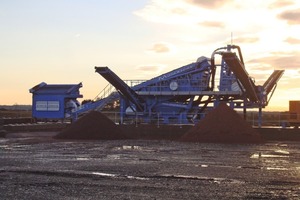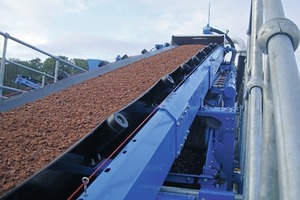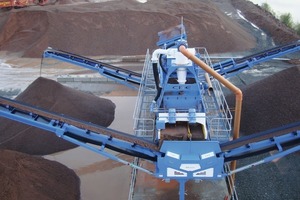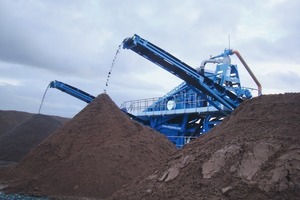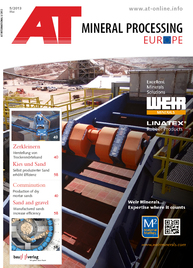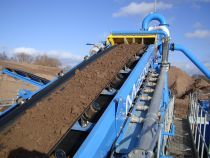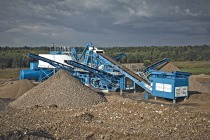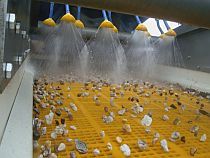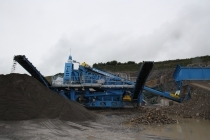Manufactured sands increase efficiency for Grange Quarry
Anew modular washing plant has allowed Grange Quarry to increase the efficiency of their concrete manufacturing operation by eliminating the requirement to buy in washed sand and aggregates. The new plant is situated at Kelhead Quarry near Annan in Scotland and includes the M2500 E4 mobile washing plant and AggMax 83 portable logwasher. Operational since October 2012 the new plant has a capacity of 200 tonnes per hour and is processing 0-75 mm limestone conglomerate material to produce a 0-4 mm washed manufactured sand as well as 4-6 mm grit and three washed aggregates – 6-10 mm, 10-20 mm and 20-40 mm. The 40-75 mm material is crushed and fed back to the washing plant.
Grange Quarry Ltd was founded in the year 2000 and supplies concrete and aggregates throughout Dumfriesshire and North Cumbria. In addition to the concrete aggregates being produced at Kelhead Quarry the company also supplies armourstone from the limestone conglomerate material. Ready Mix Concrete is produced at a depot in Kirkburn Industrial Estate, Lockerbie which opened in June 2011. In addition to the washed sand and aggregates from the new washing plant Grange Quarry Ltd also supply sub-base, crushed rock, general fill and capping materials from the main quarry at Tundergarth, Lockerbie.
The efficiency gains have come from eliminating the requirement to buy in washed sand for use in the concrete plant operated by Grange Quarry at Kirkburn, Lockerbie. “Before we bought the CDE plant we were buying in large quantities of washed sand from various sources and we are now able to produce this material ourselves” explains Stuart Dodd, Managing Director or Grange Quarry Ltd. “The washing plant has also allowed us to enhance the quality of our concrete aggregates which has not only introduced efficiencies to our production processes but further improved the quality of our concrete products.”
It was the introduction of the AggMax system that enabled Grange Quarry to produce concrete specification aggregates from the limestone conglomerate material at Kelhead Quarry. The clay present within the feed material required an attrition system which would effectively separate the clay from the limestone aggregate material. “We went to see the AggMax system in operation on a C&D waste recycling project for Malcolm Construction in Irvine in July of this year” explains Stuart Dodd. “This demonstrated to us the capability of the machine to effectively deal with the clay in our material.”
The feed material is delivered to the M2500 initially where initial screening separates the 0-6 mm sand and grit fraction from the 6-40 mm aggregate material. This aggregate material is then delivered to the AggMax which includes the Rotomax RX80 logwasher and a triple deck dewatering screen on a single chassis. Once the material has passed through the Rotomax the scrubbed aggregates are discharged onto the integrated dewatering screen where they are sized into the final product gradings. These are subsequently stockpiled by three 15 m mobile conveyors. The waste water from the AggMax containing the fines liberated by the scrubbing process is returned to the M2500.
The 0-6 mm material is washed on the M2500 to produce a 0-4 mm washed sand and 4-6 mm grit which are stockpiled via two integrated wing conveyors. The 0-6 mm material is delivered to one side of a split dewatering screen where the 0-4 mm sand falls through to the sand plant sump while the 4-6 mm material is dewatered. The 0-4 mm material is then pumped to the hydrocyclone where the 0-63 µm material is removed and the remaining material is discharged onto the dewatering screen before being stockpiled. The waste water from the sand washing phase is then discharged to settling ponds. “By minimising the fines content within our final sand product we are able to increase the efficiency of our concrete production and also produce a very high quality concrete product” says Stuart Dodd.
The M2500 and AggMax combination was chosen by Grange Quarry for this project as a result of the modular nature of the equipment which allows for quick set-up on site and also a small plant footprint. “The ability for us to get up and running very quickly was crucial in our decision to invest in the new plant” says Stuart Dodd. “We acquired the rights to extract at Kelhead quarry in June 2012 and were producing material by the end of October.”

